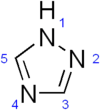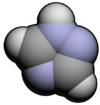1,2,4-Triazole
| |||
| Names | |||
|---|---|---|---|
| IUPAC name
1H-1,2,4-triazole | |||
| Other names
1,2,4-triazole pyrrodiazole | |||
| Identifiers | |||
| 288-88-0 | |||
| 3D model (Jmol) | Interactive image | ||
| ChEBI | CHEBI:46077 | ||
| ChEMBL | ChEMBL15571 | ||
| ChemSpider | 8900 | ||
| ECHA InfoCard | 100.005.476 | ||
| PubChem | 9257 | ||
| |||
| |||
| Properties | |||
| C2H3N3 | |||
| Molar mass | 69.00725 | ||
| Appearance | white solid | ||
| Melting point | 120 to 121 | ||
| Boiling point | 260 | ||
| very soluble | |||
| Acidity (pKa) | 10,3 | ||
| Basicity (pKb) | 11,8 | ||
| Hazards | |||
| Flash point | 140 °C (284 °F; 413 K) | ||
| Related compounds | |||
| Related compounds |
1,2,3-triazole imidazole | ||
| Except where otherwise noted, data are given for materials in their standard state (at 25 °C [77 °F], 100 kPa). | |||
| | |||
| Infobox references | |||
1,2,4-Triazole is one of a pair of isomeric chemical compounds with molecular formula C2H3N3, called triazoles, which have a five-membered ring of two carbon atoms and three nitrogen atoms. 1,2,4-Triazole is a basic aromatic heterocycle. 1,2,4-Triazole derivatives find use in a wide variety of applications, most notably as antifungals such as fluconazole and itraconazole.
1,2,4-Triazoles can be prepared using the Einhorn–Brunner reaction or the Pellizzari reaction.[1]
Unsubstituted 1,2,4-triazole can be prepared from thiosemicarbazide by acyation with formic acid and subsequent cyclization of 1-formyl-3-thiosemicarbazide into 1,2,4-triazole-3(5)-thiol; oxydation of thiol by nitric acid yelds 1,2,4-triazole.[2]
The ring structure appears in certain N-heterocyclic carbenes.
Application
- Used in the preparation of Rizatriptan, Letrozole, Vorozole, & Posaconazole.
References
- ↑ Potts K. T. (1961). "The Chemistry of 1,2,4-Triazoles.". Chemical Reviews. 61 (2): 87–127. doi:10.1021/cr60210a001.
- ↑ "1,2,4-TRIAZOLE". Organic Syntheses. 40: 99. 1960. doi:10.15227/orgsyn.040.0099. ISSN 0078-6209. Retrieved 2016-07-22.

